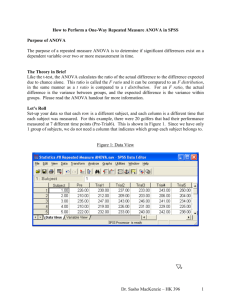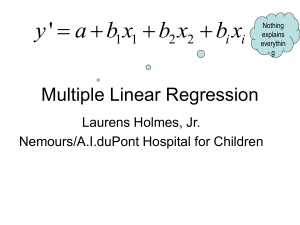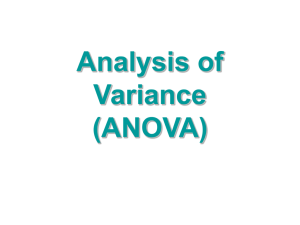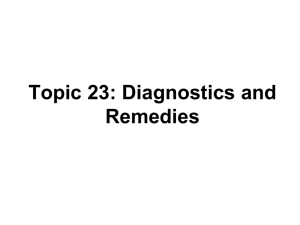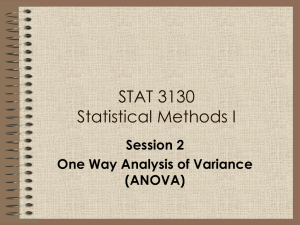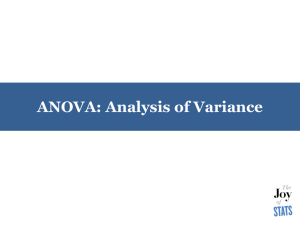Correlated Samples ANOVA
advertisement
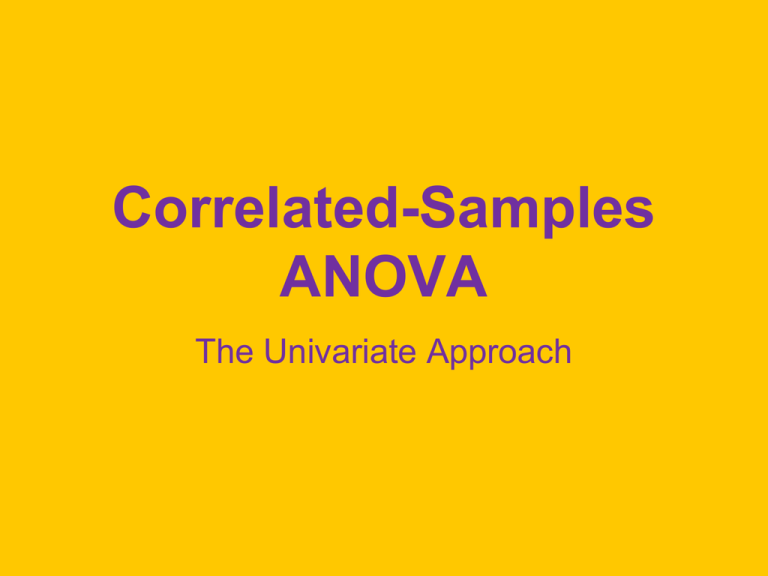
Correlated-Samples ANOVA The Univariate Approach An ANOVA Factor Can Be • Independent Samples – Between Subjects • Correlated Samples – Within Subjects, Repeated Measures – Randomized Blocks, Split Plot • Matched Pairs if k = 2 The Design • • • • DV = cumulative duration of headaches Factor 1 = Weeks Factor 2 = Subjects (crossed with weeks) The first two weeks represent a baseline period. • The remaining three weeks are the treatment weeks. • The treatment was designed to reduce headaches. The Data Subject Wk1 Wk2 Wk3 Wk4 Wk5 1 2 3 4 5 6 7 8 9 21 20 17 25 30 19 26 17 26 22 19 15 30 27 27 16 18 24 8 10 5 13 13 8 5 8 14 6 4 4 12 8 7 2 1 8 6 4 5 17 6 4 5 5 9 Crossed and Nested Factors • Subjects is crossed with Weeks here – we have score for each subject at each level of Week. • That is, we have a Weeks x Subjects ANOVA. • In independent samples ANOVA subjects is nested within the other factor – If I knew the subject ID, I would know which treatment e got. Order Effects • Suppose the within-subjects effect was dose of drug given (0, 5, 10 mg) • DV = score on reaction time task. • All subject tested first at 0 mg, second at 5 mg, and thirdly at 10 mg • Are observed differences due to dose of drug or the effect of order • Practice effects and fatigue effects Complete Counterbalancing • There are k! possible orderings of the treatments. • Run equal numbers of subjects in each of the possible orderings. • Were k = 5, that would be 120 different orderings. Asymmetrical Transfer • We assume that the effect of A preceding B is the same as the effect of B preceding A. • Accordingly, complete counterbalancing will cancel out any order effects • If there is asymmetrical transfer, it will not. Incomplete Counterbalancing • Each treatment occurs once in each ordinal position. • Latin Square ABCDE EABCD DEABC CDEAB BCDEA Power • If the correlations between conditions are positive and substantial, power will be greater than with the independent samples designs • Even though error df will be reduced • Because we are able to remove subject effects from the error term • Decreasing the denominator of the F ratio. Reducing Extraneous Variance • Matched pairs, randomized blocks, splitplot. • Repeated measures or within-subjects. • Variance due to the blocking variable is removed from error variance. Blocks Error Error Treatm ent Blocks Treatm ent Partitioning the SS • The sum of all 5 x 9 = 45 squared scores is 11,060. • The correction for the mean, CM, is (596)2 / 45 = = 7893.69. • The total SS is then 11,060 - 7893.69 = 3166.31. SS TOT Y 2 ( Y ) N 2 SSweeks • From the marginal totals for week we compute the SS for the main effect of Week as: (2012+ 1982+ 842+ 522+ 612) / 9 - 7893.69 = 2449.20. • Wj is the sum of scores for the jth week. SS weeks W j n 2 CM SSSubjects • From the subject totals, the SS for subjects is: (632+ 572+ ...... + 812) / 5 - 7893.69 = 486.71. • S is the sum of score for one subject SS subjects S n 2 i CM SSerror • We have only one score in each of the 5 weeks x 9 subjects = 45 cells. • So the traditional within-cells error variance does not exist. • The appropriate error term is the Subjects x Weeks Interaction. • SSSubjects x Weeks = SStotal – SSsubjects – SS weeks • = 3166.31 - 486.71 - 2449.2 = 230.4. df, MS, F, p • The df are computed as usual in a factorial ANOVA -- (s-1) = (9-1) = 8 for Subjects, (w-1) = (5-1) = 4 for Week, and 8 x 4 = 32 for the interaction. • The F(4, 32) for the effect of Week is then (2449.2/4) / (230.4/32) = 612.3/7.2 = 85.04, p < .01. Assumptions • Normality • Homogeneity of Variance • Sphericity – For each (ij) pair of levels of the Factor – Compute (Yi Yj) for each subject – The standard deviation of these difference scores is constant – that is, you get the same SD regardless of which pair of levels you select. Sphericity • Test it with Mauchley’s criterion • Correct for violation of sphericity by using a procedure that adjust downwards the df • Or by using a procedure that does not assume sphericity. Mixed Designs • You may have one or more correlated ANOVA factors and one or more independent ANOVA factors Multiple Comparisons • You can employ any of the procedures that we earlier applied with independent samples ANOVA. • Example: I want to compare the two baseline weeks with the three treatment weeks. • The means are (201 + 198)/18 = 22.17 for baseline, (84 + 52 + 61)/27 = 7.30 for treatment. t t Mi M j MS error 1 1 n n j i 22 . 17 7 . 30 1 1 7 . 20 27 18 • The 7.20 is the MSE from the overall analysis. • df = 32, from the overall analysis • p < .01 18 . 21 Controlling FW • Compute q t 2 – And use it for Tukey or related procedure • Or apply a Bonferroni or Sidak procedure • For example, Week 2 versus Week 3 • t = (22-9.33)/SQRT(7.2(1/9 + 1/9)) = 10.02, q = 10.02 * SQRT(2) = 14.16. • For Tukey, with r = 5 levels, and 32 df, critical q.01 = 5.05 Heterogenity of Variance • If suspected, use individual error terms for a posteriori comparisons – Error based only on the two levels being compared. – For Week 2 versus Week 3, t(8) = 10.75, q(8) = 15.2 – Notice the drop in df SAS • • • • • WS-ANOVA.sas Proc Anova; Class subject week; Model duration = subject week; SAS will use SSerror = SStotal – SSsubjects – SSweeks Source DF subject week 8 4 Source DF Model 12 Error 32 Corrected 44 Total Anova SS 486.7111 2449.200 Mean F Value Square 60.83888 8.45 612.3000 85.04 Pr > F Sum of Squares 2935.91111 230.40000 3166.31111 Mean F Value Square 244.65925 33.98 7.200000 Pr > F <.0001 <.0001 <.0001 Data in Multivariate Setup data ache; input subject week1-week5; d23 = week2-week3; cards; 1 21 22 8 6 6 2 20 19 10 4 4 3 17 15 5 4 5 4 25 30 13 12 17 5 30 27 13 8 6 6 19 27 8 7 4 And data for three more subjects Week 2 versus Week 3 • proc anova; model week2 week3 = / nouni; repeated week 2 / nom; Source DF week 1 Error(week) 8 Anova SS 722.0000 50.00000 Mean F Value Square 722.0000 115.52 6.250000 Pr > F <.0001 • The value of F here is just the square of the value of t, 10.75, reported on Slide 23, with an individual error term. proc means mean t prt; var d23 week1-week5; Proc Anova; Model week1-week5 = / nouni; Repeated week 5 profile / summary printe; Sphericity Tests Variables DF Orthogonal 9 Components Mauchly's Chi-Square Pr > ChiSq Criterion 0.2823546 8.1144619 0.5227 We retain the null that there is sphericity. Univariate Tests of Hypotheses for Within Subject Effects Source DF Anova SS week 4 Error(week) 32 2449.2 230.40 Mean F Pr > F Adj Pr > F Square Value G-G H-F 612.30 85.04 <.0001 <.0001 <.0001 7.2000 Greenhouse-Geisser Epsilon 0.6845 Huynh-Feldt Epsilon 1.0756 Epsilon • Used to correct for lack of sphericity • Multiply both numerator and denominator df by epsilon. • For example: Degrees of freedom were adjusted according to Greenhouse and Geisser to correct for violation of the assumption of sphericity. Duration of headches changed significantly across the weeks, F(2.7, 21.9) = 85.04, MSE = 7.2, p < .001. Which Epsilon to Use? • The G-G correction is more conservative (less power) than the H-F correction. • If both the G-G and the H-F are near or above .75, it is probably best to use the H-F. Profile Analysis • Compares each level with the next level, using individual error. • Look at the output. – Week 1 versus Week 2, p = .85 – Week 2 versus Week 3, p < .001 – Week 3 versus Week 4, p = .002 – Week 4 versus Week 5, p = .29 Multivariate Analysis MANOVA Test Criteria and Exact F Statistics for the Hypothesis of no week Effect Statistic Value F Num Den Value DF DF 86.39 4 5 Pr > F 0.98573 69.1126 86.39 4 86.39 4 5 5 <.0001 <.0001 Roy's Greatest 69.1126 Root 86.39 4 5 <.0001 Wilks' Lambda 0.01426 Pillai's Trace HotellingLawley Trace <.0001 Strength of Effect • 2 = SSweeks / SStotal = 2449.2/3166.3 = .774 • Alternatively, if we remove from the denominator variance due to subject, 2 partial SS Conditions SS Conditions SS Error 2449 . 2 2449 . 2 230 . 4 . 914 Higher-Order Mixed or Repeated Univariate Models • If the effect contains only betweensubjects factors, the error term is Subjects(nested within one or more factors). • For any effect that includes one or more within-subjects factors the error term is the interaction between Subjects and those one or more withinsubjects factors. AxBxS Two-Way Repeated Measures CLASS A B S; MODEL Y=A|B|S; TEST H=A E=AS; TEST H=B E=BS; TEST H=AB E=ABS; MEANS A|B; Ax(BxS) Mixed (B Repeated) CLASS A B S; MODEL Y=A|B|S(A); TEST H=A E=S(A); TEST H=B AB E=BS(A); MEANS A|B; AxBx(CxS) Three-Way Mixed (C Repeated) CLASS A B C S; MODEL Y=A|B|C|S(A B); TEST H=A B AB E=S(A B); TEST H=C AC BC ABC E=CS(A B); MEANS A|B|C; Ax(BxCxS) Mixed (B and C Repeated) CLASS A B C S; MODEL Y=A|B|C|S(A); TEST H=A E=S(A); TEST H=B AB E=BS(A); TEST H=C AC E=CS(A); TEST H=BC ABC E=BCS(A); MEANS A|B|C; AxBxCxS All Within CLASS A B C S; MODEL Y=A|B|C|S; TEST H=A E=AS; TEST H=B E=BS; TEST H=C E=CS; TEST H=AB E=ABS; TEST H=AC E=ACS; TEST H=BC E=BCS; TEST H=ABC E=ABCS; MEANS A|B|C;


